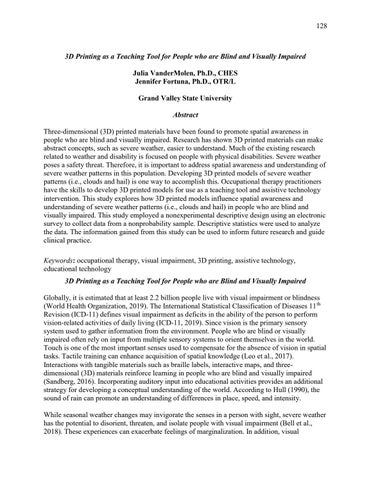128
3D Printing as a Teaching Tool for People who are Blind and Visually Impaired Julia VanderMolen, Ph.D., CHES Jennifer Fortuna, Ph.D., OTR/L Grand Valley State University Abstract Three-dimensional (3D) printed materials have been found to promote spatial awareness in people who are blind and visually impaired. Research has shown 3D printed materials can make abstract concepts, such as severe weather, easier to understand. Much of the existing research related to weather and disability is focused on people with physical disabilities. Severe weather poses a safety threat. Therefore, it is important to address spatial awareness and understanding of severe weather patterns in this population. Developing 3D printed models of severe weather patterns (i.e., clouds and hail) is one way to accomplish this. Occupational therapy practitioners have the skills to develop 3D printed models for use as a teaching tool and assistive technology intervention. This study explores how 3D printed models influence spatial awareness and understanding of severe weather patterns (i.e., clouds and hail) in people who are blind and visually impaired. This study employed a nonexperimental descriptive design using an electronic survey to collect data from a nonprobability sample. Descriptive statistics were used to analyze the data. The information gained from this study can be used to inform future research and guide clinical practice. Keywords: occupational therapy, visual impairment, 3D printing, assistive technology, educational technology 3D Printing as a Teaching Tool for People who are Blind and Visually Impaired Globally, it is estimated that at least 2.2 billion people live with visual impairment or blindness (World Health Organization, 2019). The International Statistical Classification of Diseases 11 th Revision (ICD-11) defines visual impairment as deficits in the ability of the person to perform vision-related activities of daily living (ICD-11, 2019). Since vision is the primary sensory system used to gather information from the environment. People who are blind or visually impaired often rely on input from multiple sensory systems to orient themselves in the world. Touch is one of the most important senses used to compensate for the absence of vision in spatial tasks. Tactile training can enhance acquisition of spatial knowledge (Leo et al., 2017). Interactions with tangible materials such as braille labels, interactive maps, and threedimensional (3D) materials reinforce learning in people who are blind and visually impaired (Sandberg, 2016). Incorporating auditory input into educational activities provides an additional strategy for developing a conceptual understanding of the world. According to Hull (1990), the sound of rain can promote an understanding of differences in place, speed, and intensity. While seasonal weather changes may invigorate the senses in a person with sight, severe weather has the potential to disorient, threaten, and isolate people with visual impairment (Bell et al., 2018). These experiences can exacerbate feelings of marginalization. In addition, visual
